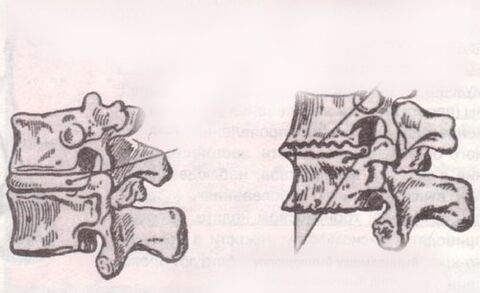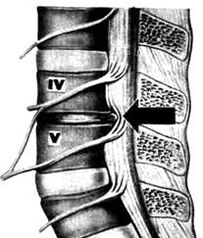Osteochondrosis of the lumbosacral spine is a dystrophic spinal disease in which the normal structure of the entire spine and especially between the liability obligations is gradually destroyed.It should be said that not only the back suffers, but also the entire organism, especially the pelvic organs and the lower limbs.

The reasons for the development
The lumbar region for the life of a person in connection with directness experiences a colossal vertical stress, which even the great size of the vertebrae cannot fully compensate.Therefore, the slightest shifts in the human body, a decrease in the muscular corset of the lower back, overweight, injuries, false movements and much more can lead to the development of the disease.In addition, you should always remember age -related changes in the spine in relation to every person.

The summary of the above can be distinguished the most common risk factors, the entirety of which leads to osteochondrosis of the lumbar spine:
- Unequal and irregular loads on the spine (lifting the severity from an inclined position, etc.).
- Obesity (almost every kilogram is important).
- Narrow injuries, including sports.
- Weakening of the sore muscles (extended work in a monotonous position, etc.).
- Infahly diet, poor in minerals and vitamins.
Symptoms
The symptoms of the disease can vary greatly, but the entirety of the main signs of osteochondrosis usually develops with three syndrome:
- Vertobroogenic lumbargia (synonym lumbago).
- Vertro -Carbon Lumboyshialgia.
- Verdro -Carbon -Schialgia (inflammation of the sciatic nerve).
In addition to pain in the lumbar cone region (with radiation for the legs, the entire building, in groin areas or without such), the tension of the lower back muscles, the weakness in the legs, the crunch during the lower back movements and the difficulties of the movements of the movements in the lumbar zone should be distinguished by a number of other important symptoms of eastochondrosis of the lumbar of lumbarars:
- Dust in the legs and a feeling of goose bumps in the legs.
- Cramps in the legs.
- Pelvic disorders (delay or incontinence of urine, constipation or diarrhea).
- Weakness in certain groups of legs.
These symptoms can orientate the neurologist to damage the spine and carry out a differential diagnosis with other diseases of the spine.
Diagnostics and X -Ray signs

Osteochondrosis should only be diagnosed with a kind of instrumental methods - radiologically.Visualize the entire structure of the spine in modern medicine enables the best MSCT or MRI study, but simple radiography has not lost its estimated value (as a screening study).It is important to remember that the main stage when diagnosing problems with the spine is a medical examination, which sometimes enables you to make a diagnosis without an examination.
In the neurological status, Pain Is Detected on Palpation of the Spicy Processes of Vertebrae, Tension of the Lower Back Muscles, and if there is is only osteochondrosis, that should be no symptoms Search as: DecreateD Tendon reflexes, impaired sensitivity, Symptoms of Tension (Signs of ComPression ofThe Spinal Cord Roots), Impaired Muscle and Muscle of the Legs, Weakness of Movement of Movement of Motion in the Bones.In the presence of these symptoms, differential diagnostics should be carried out with disc hernia and other more serious diseases of the spine.
Treatment
Treatment of the disease includes longer complete therapy.The instructions in the treatment of several drug removal of exacerbation, non -printing aid methods and the preventive method of physiotherapy exercises, some of which were used in the acute period, and still lose their relevance today.
Medication
It is a combination of myoorlaxing therapy, anti -inflammatory pathogenetic therapy and the use of neuroprotective medicines.The weight of a person, gender and the presence of simultaneous diseases takes place.
In acute time, it is advisable to inject medicines such as Diclofenac, Meloxicam.At the same time, they begin to carry out the therapy to remove muscle spasm and to protect the nerve fiber from damage.
Not -drug

It is shown by physiology and manual influences.In view of the massiveness of muscle groups, a fairly extensive level of the anatomical zone, the physioization can only be a auxiliary method.DDT, electrophoresis and magnetotherapy are used with which you can improve the effect of medicines.
However, massage and manual therapy are sometimes able to stop the symptoms of lumbar osteochondrosis completely without support for medication.This is due to the fact that muscle spasms can be removed quite well and the pain is not always provoked by the inflammatory process.Sometimes only negligent movement leads to pain, the consequences of which are effectively eliminated in the first few hours after the development of pain.
The gymnastics for the osteochondrosis of the lumbar spine aims to stretch and strengthen the muscles of the back.In the presence of the specified diagnosis, physiotherapy exercises in physiotherapy exercises should be involved daily.Subject to general rules (restriction of excessive physical activity, hypothermia), body weight control and training for osteochondrosis of the lumbar region are sometimes forgotten for many years.


























